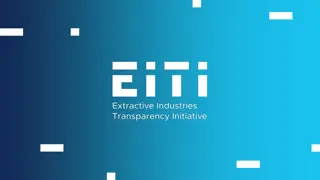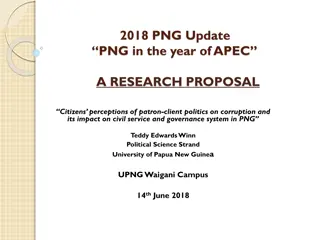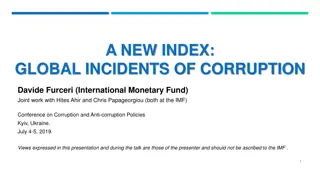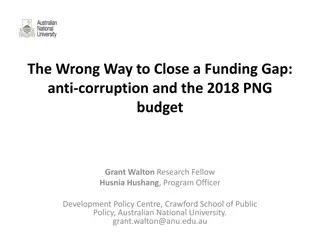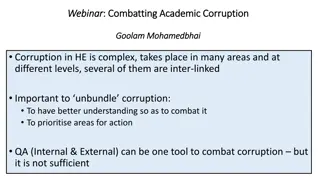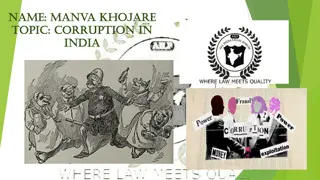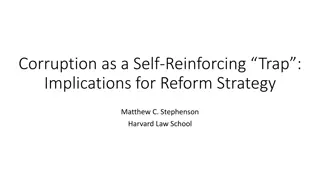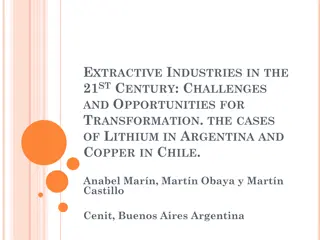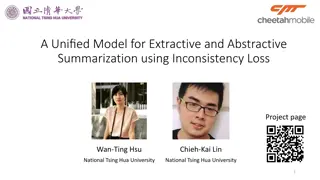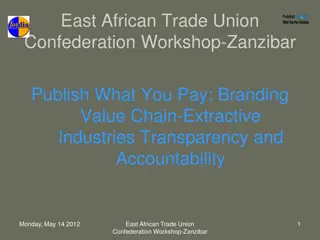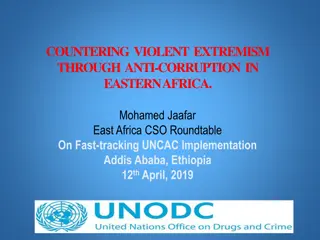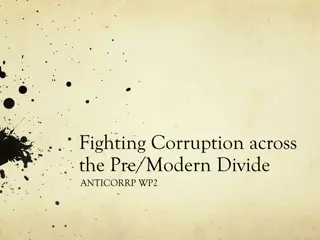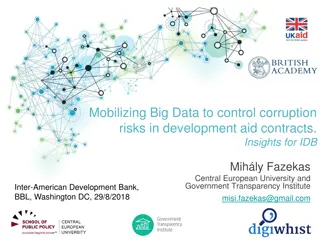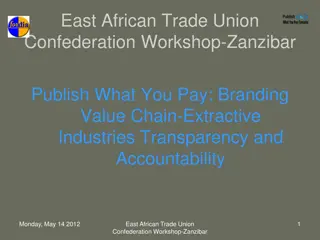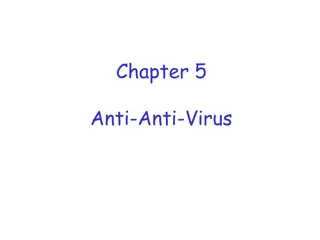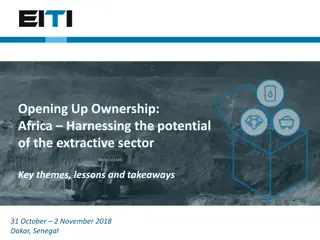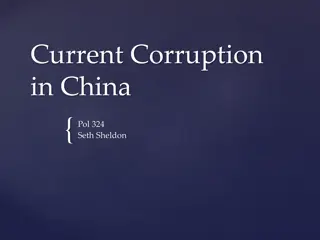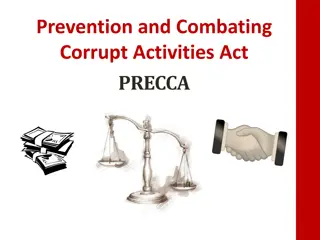Enhancing Anti-Corruption Activities in Extractive Sector Work Plans
Reflecting on anti-corruption activities in MSG work plans is crucial for good governance of oil, gas, and mineral resources. The EITI provides guidance on addressing corruption risks, with a recommended three-step approach: assess risks, develop an activity plan, and monitor results. Step 1 involves assessing corruption risks, linking activities to national reforms, and identifying vulnerable areas. Step 2 focuses on developing and implementing an activity plan, possibly including an anti-corruption component in EITI work plans. Examples highlight examining risks in licensing processes.
Download Presentation

Please find below an Image/Link to download the presentation.
The content on the website is provided AS IS for your information and personal use only. It may not be sold, licensed, or shared on other websites without obtaining consent from the author. Download presentation by click this link. If you encounter any issues during the download, it is possible that the publisher has removed the file from their server.
E N D
Presentation Transcript
Reflecting Reflecting anti anti- -corruption corruption activities activities in MSG in MSG work work plans plans The global standard for the good governance of oil, gas and mineral resources.
EITI EITI Guidance Guidance note note on on anti anti- -corruption corruption In agreeing anti-corruption activities in the work plan, the MSG could consider: 1) The extent that the extractive sector is prone to corruption risks. 2) The most prevalent corruption risks in their countries 3) Their objectives in addressing risks and alignment with national objectives 4) Potential role for the MSG in broader anti corruption reforms 5) The scope of their work on anticorruption, e.g. approach their ongoing activities on BO, contract transparency, revenue disclosure, with an anti-corruption lens 6) Use of existing tools to advance anti-corruption, e.g. EITI Reports. Validation assessments, work plan 7) Option to tackle corruption issues on areas of risk beyond the EITI Standard, e.g. service contracting, energy transition or local content.
Recommended Recommended three three- -step step approach approach: : 1. 2. Assess 3. Develop and implement an activity plan corruption risks and formulate objectives Monitor results
Step Step 1: objectives to address them objectives to address them 1: Assess corruption risks and formulate Assess corruption risks and formulate How can MSG activities link to broader national reforms on anti-corruption? Which stages of the extractive industry value chain are most prone to corruption issues? Which commodities and sub-sectors are most vulnerable to corruption, e.g. critical minerals? Are there loopholes in policies and practices that heighten corruption risks? Are there areas of extractive management that are at high risk of corruption, that are not covered by the EITI Standard?
Example Example: : MSGs in in licensing licensing could MSGs that could look that want want to look into to examine examine risks into: : risks The weaknesses of the bidding process Loopholes in regulations How gaps in systems and lack of transparency in regulations make it possible for political capture and conflicts of interest to occur Shortcuts /deviations from or fas tracked licensing procedures, e.g. for critical minerals
Step 2: Develop and implement an activity plan Step 2: Develop and implement an activity plan Could activities in the EITI work plan include an anti-corruption component? Are there potential constraints? If so, what measures would address them? Has the role of the MSG on corruption mitigation been defined and articulated and have responsibilities for the various activities been assigned to relevant stakeholders? Does the activity plan reinforce and leverage the strengths of the EITI national process?
Example Example of of Anti activities activities Anti- -corruption corruption Technical studies Technical studies on the types of risks in a particular sector/commodity Use of diagnostic tools Use of diagnostic tools such as NRGI s corruption diagnostic tool and Transparency International s Mining Awards Corruption Risk Assessment (MACRA) tool. Formulation of recommendations/safeguards Formulation of recommendations/safeguards against corruption. against corruption. Capacity building and awareness raising Capacity building and awareness raising, e..g on corruption risks in the extractive sector and the role of EITI in corruption mitigation, how to effectively use and analyse data to inform anticorruption efforts and detect red flags. Analysis of corruption cases to Analysis of corruption cases to understand how corruption occurs, identify enablers, highlight what types of transactions are vulnerable to risks.
Roles Roles that corruption corruption Supporting citizens discussion, monitoring and advocacy Supporting citizens discussion, monitoring and advocacy, e.g.MSG can follow up on concerns revealed in EITI Reports about payments not being recorded in the Treasury Analysing Analysing current EITI disclosures and providing recommendations to current EITI disclosures and providing recommendations to strengthen government systems. strengthen government systems. Demanding or disclosing complementary data Demanding or disclosing complementary data, e.g. asset declarations of politically exposed persons, service contracting, or risks in the renewable energy sector. Facilitating inter Facilitating inter- -agency cooperation agency cooperation, e.g company register for BO information and tax authority or licensing authority that the the MSG MSG could could play play on on anti anti- -
Step 3: Monitor results Step 3: Monitor results What should be monitored and how? How to select data sources and indicators? How to identify appropriate roles and expertise? How can monitoring align with existing EITI processes? What are the opportunities to learn from monitoring and review?
Monitoring Monitoring results results could could be be through through Work planning Validation Annual progress reports
For For discussion discussion: : What are the opportunities to strengthen anti-corruption work through the EITI process in our countries? What are the most pressing challenges to advance this work? What practical guidance do you need to address these challenges? What additional support is needed from the EITI Secretariat to further work on anti-corruption at the country level?


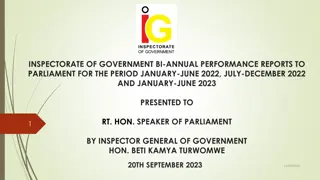
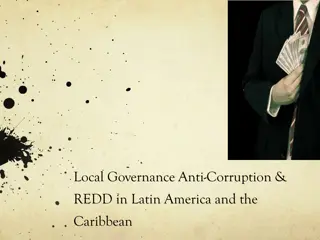
![Comprehensive Overview of Corruption Watch Submission on Public Procurement Bill [B18B-2023]](/thumb/138344/comprehensive-overview-of-corruption-watch-submission-on-public-procurement-bill-b18b-2023.jpg)
